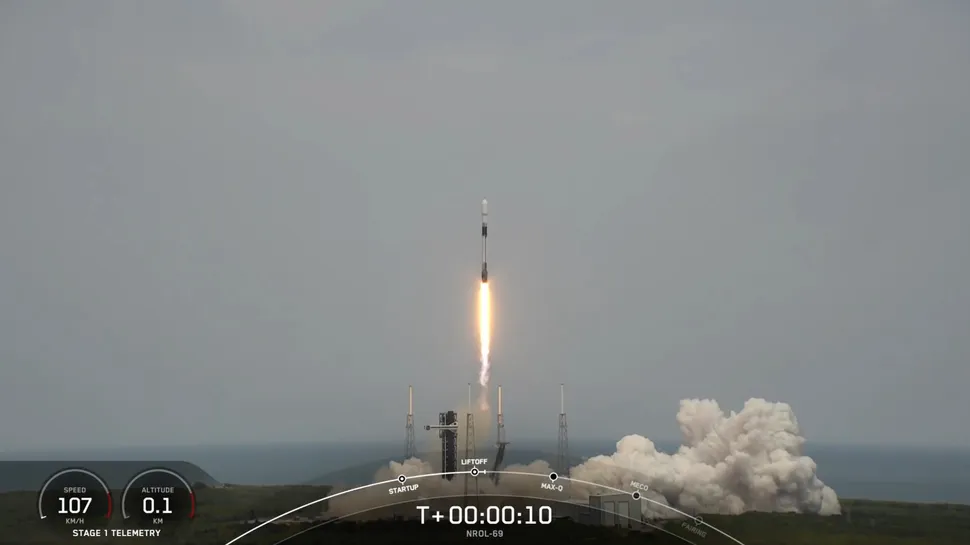SpaceX Marks 19th Anniversary with Secret U.S. Spy Satellite Launch

On March 24, 2025, a SpaceX Falcon 9 rocket successfully carried the classified NROL-69 mission for the U.S. National Reconnaissance Office into orbit. The launch took place at Cape Canaveral Space Force Station in Florida. (Image credit: SpaceX)
Cape Canaveral, Florida – March 25, 2025
Yesterday, on the 19th anniversary of its first-ever rocket liftoff, SpaceX successfully launched a clandestine U.S. spy satellite into orbit, further solidifying its pivotal role in America’s space and defense landscape. The mission, shrouded in secrecy, took off from Cape Canaveral Space Force Station at 1:48 p.m. EDT (1748 GMT) on March 24, 2025, aboard a Falcon 9 rocket, captivating onlookers and underscoring the company’s remarkable journey from a fledgling startup to a global space powerhouse.
The launch, designated NROL-69, was conducted for the National Reconnaissance Office (NRO), the U.S. agency responsible for managing the nation’s fleet of spy satellites. While details about the satellite’s purpose and capabilities remain classified, the timing of the mission—coinciding with the anniversary of SpaceX’s inaugural Falcon 1 launch on March 24, 2006—added a layer of historical significance. That first launch, which ended in failure, marked the beginning of a steep climb for Elon Musk’s ambitious venture. Nineteen years later, SpaceX has transformed the space industry with reusable rockets and an unmatched launch cadence.
The Falcon 9 lifted off flawlessly under partly cloudy skies, its first stage roaring to life before separating and landing back at Cape Canaveral shortly after. This was the second flight for this particular booster, demonstrating SpaceX’s commitment to cost-effective rocket reuse. Stunning photographs captured the rocket piercing the atmosphere and the booster’s graceful descent, a testament to the engineering precision that has become the company’s hallmark.
“Today’s launch is a fitting tribute to where we started and how far we’ve come,” SpaceX wrote in a brief statement on X, accompanied by a live stream of the event. The webcast, however, cut off shortly after the first-stage landing at the NRO’s request, leaving the satellite’s deployment a mystery to the public.
The NROL-69 mission is SpaceX’s third for the NRO in 2025, following NROL-153 in January and NROL-57 on March 21. These missions are part of the NRO’s shift toward a “proliferated architecture”—a network of numerous smaller, agile satellites designed for enhanced resilience and responsiveness. This approach contrasts with the agency’s historical reliance on fewer, larger, and more expensive spacecraft. While the NRO has not disclosed specifics, experts speculate that NROL-69 contributes to this expansive surveillance constellation, potentially bolstering U.S. military capabilities with near-constant Earth observation.
The anniversary launch comes as SpaceX continues to break records. Just days earlier, on March 21, the company set a new benchmark for rocket reuse when a Falcon 9 first stage flew its second mission in a mere nine days for the NROL-57 launch. With over 100 Falcon 9 flights already logged in 2024, SpaceX’s pace shows no signs of slowing as it balances government contracts, Starlink deployments, and ambitious projects like the Starship program.
Reflecting on the company’s origins, Musk has often recounted the early struggles of SpaceX, including three failed Falcon 1 launches before a successful flight in 2008. The Falcon 9, which debuted in 2010, has since become the workhorse of the fleet, retiring its predecessor and enabling feats like today’s precise booster landing—a far cry from the fiery crash of that first attempt 19 years ago.
As images of the NROL-69 launch circulate online, from the rocket’s fiery ascent to the booster standing triumphantly post-landing, the mission serves as both a celebration of SpaceX’s past and a glimpse into its future. While the satellite’s secretive payload remains beyond public view, its journey into orbit marks another milestone in SpaceX’s ongoing quest to redefine space exploration—and national security—for the modern era.